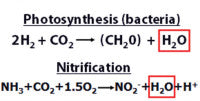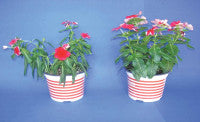The science of water management by microorganisms
 Water management is becoming increasingly difficult and expensive for landscapers and turf managers. Rising municipal water prices and water restrictions that are now in place in more and more areas are adding to the already difficult water maintenance for turfcare professionals. New technologies that help to cut back the need for water use without affecting turf quality are badly needed. The increased use of beneficial bacteria and humic substances is becoming increasingly commonplace to help turf managers solve these problems.
Water management is becoming increasingly difficult and expensive for landscapers and turf managers. Rising municipal water prices and water restrictions that are now in place in more and more areas are adding to the already difficult water maintenance for turfcare professionals. New technologies that help to cut back the need for water use without affecting turf quality are badly needed. The increased use of beneficial bacteria and humic substances is becoming increasingly commonplace to help turf managers solve these problems.
Scientific studies and field studies have demonstrated significant water and subsequent cost savings using a combination of beneficial bacteria and humic acids. This dual approach to water retention and delivery has an additive effect in creating a more hospitable environment for turf growth, especially during hot or dry periods.
Beneficial bacteria help to retain and provide water through multiple mechanisms. First, the cellular content of a prokaryotic bacterial cell is anywhere from 60% to 80% water. That means that the majority of what is being added to soil, when inoculating with beneficial bacteria, is water. Also, the bacterial biomass provides a giant "buffering" and retention system for the water that does not make water available, unless it is needed.
When water is available, the bacteria divide and incorporate it into their cell bodies. When conditions become dry, the bacteria can re-release this water to make it available to the turf or plant again. Since excess sitting water can lead to disease and pest pressure (from organisms such as pathogenic fungi, or providing a breeding ground for mosquitoes), having the water buffered in bacterial cells, as opposed to sitting or pooling, provides multiple advantages.
 Secondly, bacteria store and retain water in biofilms. Beneficial biofilms are polysaccharides (sugars) secreted by beneficial bacteria that they use to retain nutrients and water. Polysaccharides can bind many times their weight in water. This is a tremendous amount of water retained in the soil that would otherwise wash through or evaporate. This water is also concentrated in the rhizosphere around the rootzones, where the microbes are concentrated.
Secondly, bacteria store and retain water in biofilms. Beneficial biofilms are polysaccharides (sugars) secreted by beneficial bacteria that they use to retain nutrients and water. Polysaccharides can bind many times their weight in water. This is a tremendous amount of water retained in the soil that would otherwise wash through or evaporate. This water is also concentrated in the rhizosphere around the rootzones, where the microbes are concentrated.
Thirdly, beneficial microbes produce water as a by-product of their normal functions, for such metabolic activities as bacterial photosynthesis and products of cycling nitrogen.
When you breathe onto a mirror or glass, you will see the water that your body expels as a by-product of its metabolism. Having billions of bacteria constantly "breathing" in the soil is analogous to this process, producing water, except it is released into the soil. 
Fourthly, the decomposition of organic matter releases water, and this process is driven by microbes in the soil. By adding beneficial microbes, the decomposition of organic material (such as the breakdown of thatch) speeds up, and water is consequently made available to plants and turf.
For every one gramme of organic material, anywhere from 0.5 to 0.75 of a gramme of water is produced. Adding supplemental microbial life to the soil is a significant source of constant water production.
 Humic substances also help retain and release water in the soil. Humic substances are large organic molecules that are the end-products of the decomposition of organic matter. They are an excellent source of organic matter. However, they are also a great way to bind and retain micronutrients near the root system of plants that would otherwise be lost. Humic substances contain a mixture of large, highly charged organic molecules. These molecules act like sponges, and are able to hold seven times their volume in water. Most of the organic matter in soil is in the top 2-8 inches, or where the roots are, humic substances provide another system that can re-release this water when the soil dries out, and right at the rootzone where a plant needs it most.
Humic substances also help retain and release water in the soil. Humic substances are large organic molecules that are the end-products of the decomposition of organic matter. They are an excellent source of organic matter. However, they are also a great way to bind and retain micronutrients near the root system of plants that would otherwise be lost. Humic substances contain a mixture of large, highly charged organic molecules. These molecules act like sponges, and are able to hold seven times their volume in water. Most of the organic matter in soil is in the top 2-8 inches, or where the roots are, humic substances provide another system that can re-release this water when the soil dries out, and right at the rootzone where a plant needs it most.
 Adding beneficial bacteria and the humic substances together only enhances the water retention abilities of soil, as proven with extensive field testing. The vina picture demonstrates this principle. These vincas received 64 ounces of water each, then were not watered for six days. The vinca on the right received a treatment of a combination of beneficial bacteria and humates with the watering (2% Quantum Growth). The vinca on the left did not. The untreated vinca is succumbing to the effects of drought, whilst the vinca that received the treatment remains healthy and turgid, even after the six days without water.
Adding beneficial bacteria and the humic substances together only enhances the water retention abilities of soil, as proven with extensive field testing. The vina picture demonstrates this principle. These vincas received 64 ounces of water each, then were not watered for six days. The vinca on the right received a treatment of a combination of beneficial bacteria and humates with the watering (2% Quantum Growth). The vinca on the left did not. The untreated vinca is succumbing to the effects of drought, whilst the vinca that received the treatment remains healthy and turgid, even after the six days without water.
Integrating a combination of beneficial bacteria and humates, such as that found in our technology, will dramatically reduce your water use, and the subsequent labour and costs associated with irrigation, whilst improving the look and health of your turf and plants, whilst decreasing drought stress.
